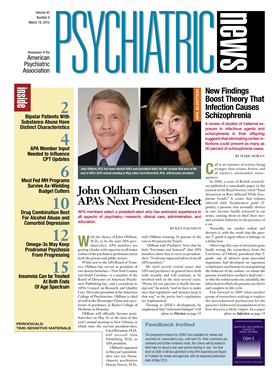In the normal state of affairs, the word “resistance” can have various meanings. For example, it can mean opposition, defense against an attack, or bodily protection from disease.
But in the psychiatric-psychoanalytic sphere, the word “resistance” means something starkly different—patients' unconscious tendency to fend off help offered them by the therapist.
And some valuable insights into this type of resistance were offered at the 2010 annual meeting of the American Psychoanalytic Association in New York in January by a veteran in dealing with and teaching about this phenomenon. He is Glen Gabbard, M.D., a professor of psychiatry and Brown Foundation Chair of Psychoanalysis at Baylor College of Medicine.
The session, designed especially for psychiatry residents and analysts in training, was packed. One of the residents who attended the session later told Psychiatric News that he had learned a lot from it.
“Some of us think the term 'resistance' is not the best term for it—it sounds as though you are butting heads with the patient,” said Gabbard. “In any event, today we believe that resistance reveals rather than conceals, that is, it shows you who the patient really is.”
An example of resistance, he noted, is when a patient repeatedly claims something such as, “My parents loved me very much,” whereas the opposite appears to be the case. Or as Shakespeare would put it: “The lady doth protest too much!” Another instance of resistance could be when a patient often comes late for therapy or doesn't show up at all.
One of the biggest reasons for resistance, Gabbard continued, is that patients fear that the therapist is going to shame them. “A big part of shame involves exposure, and there is no place you are more naked than in therapy.”
So how should a clinician approach a patient's resistance?
“One of the most important things I've learned about resistance,” Gabbard stressed, “is that you don't make the patient do therapy the way you want to do it, but rather you adapt to how the patient has to do it. We have to remember that therapy is not coercive. We have to respect the patient's autonomy. Freud would put his hand on a patient's forehead and say, 'You will remember!' It didn't work very well.”
Clinicians should also avoid coming across as know-it-alls when they suspect that patients are resisting, Gabbard said. Clinicians should offer an observation to patients and then ask them what they think about it.
Patient dishonesty can be a form of resistance, Gabbard pointed out. When patients reveal that they have been dishonest, it is important not to jump on it, but rather to say, “I'm glad that you are telling me this because openness in therapy is so important.” You have to create a nonjudgmental atmosphere of acceptance in therapy.
“If patients don't return for treatment, we therapists often blame ourselves,” Gabbard continued. “But it isn't necessarily our fault. Sometimes patients stop coming because of resistance—for example, they may fear emotional closeness with the therapist or need to retreat within themselves and consolidate emotionally charged material before they proceed with therapy.”
Also, in the event that clinicians are doing cognitive-behavioral therapy (CBT) with a patient, and he or she doesn't do a CBT-related homework assignment, this too can be understood as a form of resistance, Gabbard remarked. Clinicians could then explore with patients what it is that makes them reluctant to do the homework. In other words, clinicians can incorporate psychodynamic techniques into CBT.
“Remember,” Gabbard stressed, “we often fly by the seat of our pants in trying to help our patients, and the therapeutic alliance is consistently the most important predictor of therapeutic outcome regardless of the therapy used.”

